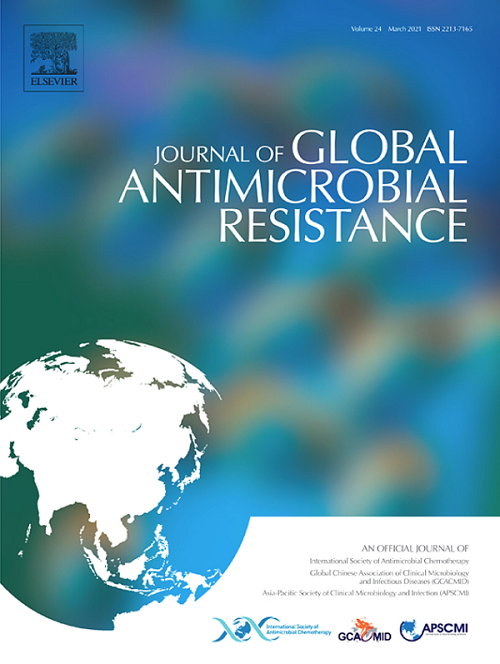从不同环境样本中鉴定新的fox家族决定因素。
IF 3.7
3区 医学
Q2 INFECTIOUS DISEASES
引用次数: 0
摘要
目的:本研究旨在在不同的环境样本中鉴定新的磷霉素耐药基因,范围包括人为污染水平。我们专注于磷霉素耐药,并考虑到其日益增加的临床重要性,探索这些基因在不同环境背景下的患病率。方法:从印度、瑞典和南极洲采集的废水和沉积物样本中提取宏基因组DNA。制备1类整合子基因磁带库,在磷霉素补充培养基上筛选抗性克隆。进行长读测序,然后进行生物信息学分析以鉴定新的磷霉素耐药基因。在大肠杆菌中克隆了这些基因并进行了功能鉴定,并评估了膦甲酸酯对这些酶的影响。结果:鉴定出4个新的磷霉素耐药基因。系统发育分析将这些基因置于FosX家族,这是一组不通过硫醇偶联水解磷霉素的金属酶。这些基因随后被重新命名为fosE2、fosI2、fosI3和fosP。功能测定证实,这些基因在大肠杆菌中具有对磷霉素的耐药性,MIC范围为32 μg/ml至256μg/ml。与FosA/B酶不同,这些fox样蛋白对膦甲酸盐的抑制作用具有抗性。在铜绿假单胞菌中发现了一个fosI3同源物,突出了潜在的临床相关性。结论:本研究通过在不同环境中鉴定新的FosX家族成员,扩大了对磷霉素耐药的认识。磷酸甲酸酯抑制的缺乏强调了这些研究较少的酶的临床重要性,值得进一步研究,特别是在致病背景下。本文章由计算机程序翻译,如有差异,请以英文原文为准。
Identification of novel FosX family determinants from diverse environmental samples
Objectives
This study aimed to identify novel fosfomycin resistance genes across diverse environmental samples, ranging in levels of anthropogenic pollution. We focused on fosfomycin resistance, and given its increasing clinical importance, explored the prevalence of these genes within different environmental contexts.
Methods
Metagenomic DNA was extracted from wastewater and sediment samples collected from sites in India, Sweden, and Antarctica. Class 1 integron gene cassette libraries were prepared, and resistant clones were selected on fosfomycin-supplemented media. Long-read sequencing was performed followed by bioinformatics analysis to identify novel fosfomycin resistance genes. The genes were cloned and functionally characterized in E. coli, and the impact of phosphonoformate on the enzymes was assessed.
Results
Four novel fosfomycin resistance genes were identified. Phylogenetic analysis placed these genes within the FosX family, a group of metalloenzymes that hydrolyse fosfomycin without thiol conjugation. The genes were subsequently renamed fosE2, fosI2, fosI3, and fosP. Functional assays confirmed that these genes conferred resistance to fosfomycin in E. coli, with MIC ranging from 32 μg/ml to 256 μg/ml. Unlike FosA/B enzymes, these FosX-like proteins were resistant to phosphonoformate inhibitory action. A fosI3 homolog was identified in Pseudomonas aeruginosa, highlighting potential clinical relevance.
Conclusions
This study expands the understanding of fosfomycin resistance by identifying new FosX family members across diverse environments. The lack of phosphonoformate inhibition underscores the clinical importance of these poorly studied enzymes, which warrant further investigation, particularly in pathogenic contexts.
求助全文
通过发布文献求助,成功后即可免费获取论文全文。
去求助
来源期刊

Journal of global antimicrobial resistance
INFECTIOUS DISEASES-PHARMACOLOGY & PHARMACY
CiteScore
8.70
自引率
2.20%
发文量
285
审稿时长
34 weeks
期刊介绍:
The Journal of Global Antimicrobial Resistance (JGAR) is a quarterly online journal run by an international Editorial Board that focuses on the global spread of antibiotic-resistant microbes.
JGAR is a dedicated journal for all professionals working in research, health care, the environment and animal infection control, aiming to track the resistance threat worldwide and provides a single voice devoted to antimicrobial resistance (AMR).
Featuring peer-reviewed and up to date research articles, reviews, short notes and hot topics JGAR covers the key topics related to antibacterial, antiviral, antifungal and antiparasitic resistance.
 求助内容:
求助内容: 应助结果提醒方式:
应助结果提醒方式:


